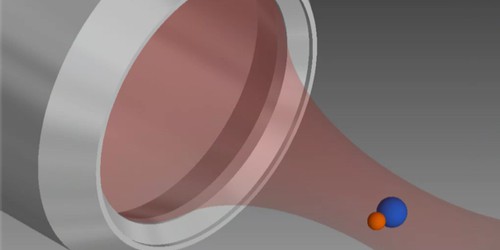A method of optically selecting and sorting nanoparticles according to their quantum mechanical properties has been developed by researchers in Japan. The method could prove a crucial tool for makers of nanostructures that have applications in quantum sensing, biological imaging and quantum information technology.
Scientists have several ways of manipulating and positioning tiny objects without touching them. Optical tweezers, for example, use a highly focused laser beam to generate optical forces that hold and move objects in the beam’s trajectory. Such tweezers have become powerful tools in biological research, microfluidics and micromechanics. However, they can only manipulate relatively large objects, because diffraction restricts the spot size of the trapping laser beam to around half the wavelength of the illuminating light. For red light with a wavelength of 700 nm and a laser power of several mW, for example, tweezers can only stably trap and manipulate objects with a diameter of roughly 350 nm or greater. Trapping and manipulating smaller particles is challenging because the optical force weakens as the volume of the particle decreases.
Nanodiamonds with luminescent centres
In the new work, a team led by Hajime Ishihara of Osaka University and Keiji Sasaki at Hokkaido University developed a way of sorting nanodiamonds, which are tiny pieces of semiconducting dots with optoelectronic properties that derive from bulk diamond as well as certain defects. One such defect, known as a nitrogen-vacancy (NV) centre, occurs when neighbouring carbon atoms in the diamond lattice are replaced by a nitrogen atom and a vacancy. These defects are a promising platform for quantum optics devices because they serve as luminescent centres – meaning that they absorb light at one specific, resonant, frequency while emitting it at another.
When illuminated by a laser, the nanodiamonds scatter light while their NV centres (if they have any) absorb it. The combination of light scattering and absorption transfers momentum from the photons to the nanoparticles, and the different momentum transfers experienced by nanodiamonds with and without NV centres could, in principle, be used to differentiate them. In practice, though, it isn’t straightforward.
“While these two effects [scattering and absorption] produce optical forces that can be used to move the particles on the macroscopic scale, it is difficult to select nanodiamonds that contain NV-centres from surrounding pristine nanodiamonds that don’t contain these defects,” Ishihara and Sasaki explain. “This is because the scattering optical force of bulk diamond is much stronger than the optical force coming from light absorbed by NVs.”
Restricting particle motion
The researchers’ solution was to balance out the larger scattering force so that they could distinguish the absorbing force due to the NV centres. To do this, they send two different-coloured laser beams propagating in opposite directions along a nanofibre. An intense evanescent light field forms around this fibre, which is several millimetres long with a diameter of a few hundred nanometres. This field, explain Ishihara and Sasaki, allows light to propagate for long distances while remaining as a tightly focused beam, thus restricting the motion of nanoparticles trapped within it to one dimension.
Within such a waveguide, the momentum of the photons is constant, making the setup ideal for analysing the optical forces exerted on the nanoparticles. By balancing the absorption and scattering forces induced by the two laser beams along the nanofibre, the researchers were able to transport single nanoparticles according to whether NV centres were present.

Researchers form single molecule in an optical tweezer
While the team focused on nanodiamonds in this work, Ishihara and Sasaki point out that other nanoparticles could be “equally interesting targets”. Indeed, they now plan to study ways of applying similar methods to nanomaterials such as organic-dye doped nanoparticles and different types of semiconducting quantum dot structures. “We are aiming to sort nanoparticles with a single quantum state (that is, with a single luminescent centre) and develop a technique to sort a huge number of particles for use in practical applications,” they tell Physics World.
Full details of the present research are reported in Science Advances.
